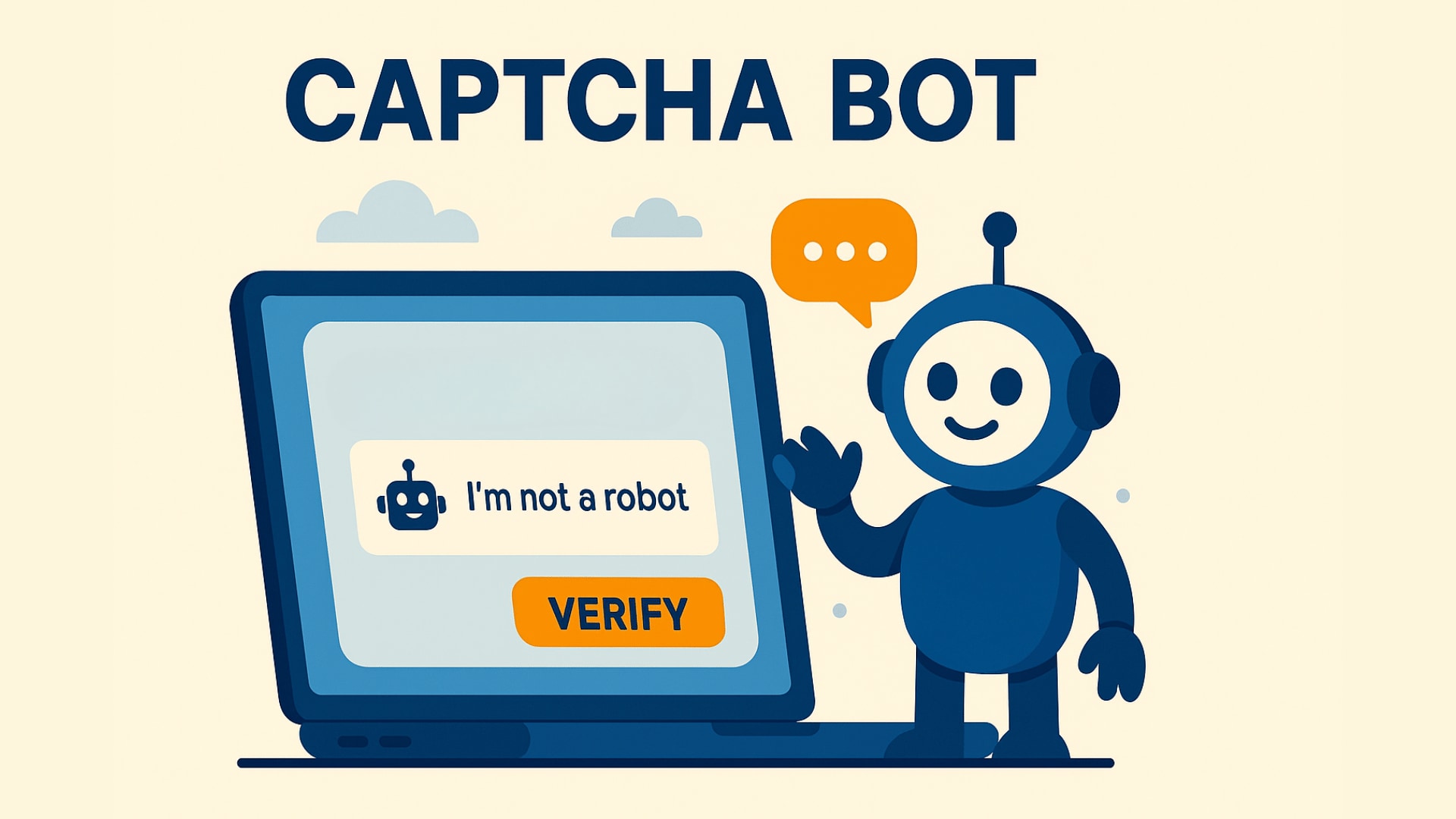
As more businesses and services move online, protecting web platforms from automated abuse has become increasingly challenging. CAPTCHA (Completely Automated Public Turing test to tell Computers and Humans Apart) systems have long served as a first line of defense. But as security measures evolve, so do the tools designed to bypass them. CAPTCHA bots — automated programs built to solve or evade these tests — have emerged as a serious cybersecurity threat.
In this article, we’ll explore what CAPTCHA bots are, how they operate, why they’re dangerous, and what organisations can do to defend against them.
Table of contents
- What Exactly Is a CAPTCHA Bot?
- How CAPTCHA Bots Operate
- Growing Role of AI in CAPTCHA Evasion
- Why CAPTCHA Bots Are Dangerous to Online Businesses
- Evolving Beyond Traditional CAPTCHA
- Real-World Impact: How CAPTCHA Bots Disrupt Industries
- The Role of captcha.eu in Protecting Your Digital Business
- Conclusion
- FAQ – Frequently Asked Questions
What Exactly Is a CAPTCHA Bot?
A CAPTCHA bot is a type of automated software built to bypass human verification tests on websites. These bots are far more sophisticated than ordinary web crawlers or scrapers. While traditional bots might index content or automate form submissions, CAPTCHA bots specifically target security checkpoints designed to block them. Their goal is to trick websites into thinking a human user is interacting with the interface, opening the door to fraud, spam, and abuse.
Unlike basic bots, CAPTCHA bots are typically deployed in cyberattack campaigns. They may be used to create fake accounts, perform credential stuffing attacks, abuse e-commerce systems, scrape valuable data, or bypass rate-limiting mechanisms. For IT managers and business decision-makers, understanding the capabilities of these bots is critical to defending their digital infrastructure.
How CAPTCHA Bots Operate
To circumvent CAPTCHA challenges, these bots use a range of increasingly advanced techniques. Some rely on traditional automation and scripting, while others deploy artificial intelligence to break through human verification barriers.
One of the most common techniques is Optical Character Recognition (OCR). OCR tools scan distorted CAPTCHA text images and reconstruct the characters. Modern bots train machine learning models on thousands of examples, enabling them to decipher even moderately distorted text with high accuracy.
More recent CAPTCHAs use image-based challenges — like identifying traffic lights or animals. To bypass these, bots use image recognition models powered by convolutional neural networks (CNNs). These bots are trained on vast image datasets and can often outperform older CAPTCHA types. Some models even use reinforcement learning to improve with every attempt.
Another method involves browser emulation and human behaviour simulation. Using headless browsers, bots simulate human interactions: realistic mouse movements, keystrokes, scrolling, and timing patterns. These behaviours help them evade systems that analyze user activity for suspicious signals.
Perhaps most concerning is the use of human CAPTCHA-solving services or CAPTCHA farms. CAPTCHA bots send real-time challenges to networks of low-cost human workers who solve them manually. These answers are fed back into the bot in seconds. This hybrid model — automation assisted by human intelligence — is incredibly difficult to block using traditional detection tools.
Growing Role of AI in CAPTCHA Evasion
Recent advances in artificial intelligence have elevated the threat level posed by CAPTCHA bots. AI-powered CAPTCHA solvers can generate responses that are nearly indistinguishable from human behaviour. For example, language models can fill in textual prompts, and generative adversarial networks (GANs) are sometimes used to craft convincing interaction patterns.
Some bots are now trained using synthetic CAPTCHA datasets, which allow them to adapt to new CAPTCHA formats without needing to interact with real-world systems. As CAPTCHA systems evolve, bots do too — creating an ongoing arms race between attackers and defenders.
Why CAPTCHA Bots Are Dangerous to Online Businesses
CAPTCHA bots can have far-reaching consequences for websites and digital platforms.
They enable the mass creation of fake accounts, which can be used for spam, fraud, misinformation, or political manipulation. Fake users dilute the value of a platform, distort analytics, and overwhelm legitimate users.
In credential stuffing attacks, CAPTCHA bots use lists of stolen usernames and passwords to gain unauthorised access to real accounts. This can lead to data breaches, financial theft, and compliance violations.
E-commerce platforms face particular risks. Bots can scrape pricing data, buy out limited-stock items, or exploit promotional offers—damaging revenue, supply chains, and customer trust. Events like concert ticket releases or product drops are often disrupted by bots purchasing goods in bulk before humans have a chance.
In some cases, excessive bot traffic can cause system outages or lead to inflated infrastructure costs. Since bots generate large volumes of automated requests, they strain bandwidth and server resources, degrading the experience for legitimate users.
Beyond these technical and financial impacts, CAPTCHA bots can cause reputational damage and lead to regulatory scrutiny. A business that fails to protect user data or allows its platform to be abused may lose customer trust and face fines under laws like the GDPR or CCPA.
Evolving Beyond Traditional CAPTCHA
While CAPTCHA systems remain a core part of web security, they must be part of a multi-layered defence strategy to be effective against modern threats.
Advanced bot management solutions now include a mix of:
- Behavioural analysis, which tracks anomalies in interaction patterns
- Time-based submission checks to flag abnormally fast inputs
- Device fingerprinting to identify reused or suspicious configurations
- Rate limiting and IP blocking to manage suspicious traffic
- Honeypots that trap bots by presenting hidden fields
Equally important is the use of adaptive CAPTCHAs. Unlike static challenges, adaptive CAPTCHAs assess the user’s behaviour and risk level before issuing a challenge. If the behaviour appears human-like and low risk, the CAPTCHA may be skipped. High-risk behaviour triggers more complex verification tasks. This preserves user experience while raising the bar for bots.
Businesses should also implement multi-factor authentication, IP whitelisting and real-time traffic monitoring to defend against advanced attacks. Moreover, content moderation tools and anomaly detection help prevent fake accounts from spreading malware or disinformation.
Real-World Impact: How CAPTCHA Bots Disrupt Industries
From ticketing platforms and e-commerce stores to social networks and financial services, no sector is immune. Concert ticket vendors lose millions to scalper bots. Online retailers see their stock depleted before humans can make purchases. Even government and healthcare portals face bot abuse aimed at harvesting sensitive information or disrupting services.
One notable case involved sneaker bots overwhelming a major sportswear brand’s online store during a limited release. CAPTCHA bots, paired with real-time proxies and automation, enabled a handful of users to grab thousands of units, frustrating legitimate customers and tarnishing the brand’s reputation.
The Role of captcha.eu in Protecting Your Digital Business
At captcha.eu, we understand the evolving nature of bot threats. That’s why we provide GDPR-compliant, privacy-friendly CAPTCHA solutions designed to adapt to sophisticated bypass techniques.
Our advanced CAPTCHA systems combine behavioural data analysis with risk assessment to present frictionless challenges to humans — while stopping bots in their tracks. Whether you’re looking to prevent fake account creation, stop spam or protect high-value content, our tools help you stay ahead in the ongoing battle against automated abuse.
Our focus isn’t just on blocking bots — it’s on helping you maintain trust, performance, and compliance across your digital services.
Conclusion
CAPTCHA bots represent a growing challenge for businesses seeking to maintain secure, reliable, and user-friendly websites. As bots become smarter and more human-like, traditional defences must evolve.
Relying solely on static CAPTCHA systems is no longer enough. Organisations must adopt a layered approach that integrates behavioural detection, real-time analysis, and adaptive challenges. Proactive protection, combined with user-friendly design, ensures both security and satisfaction.
If you’re ready to upgrade your defences and future-proof your website security, explore how captcha.eu can support your mission. We’re here to help you keep the humans in — and the bots out.
FAQ – Frequently Asked Questions
What is a CAPTCHA bot?
A CAPTCHA bot is an automated program designed to bypass CAPTCHA challenges on websites. Unlike standard bots that crawl or automate simple tasks, CAPTCHA bots are engineered to solve or circumvent human verification tests, allowing them to perform fraudulent actions like account creation, data scraping, or brute-force login attempts.
How do CAPTCHA bots bypass security tests?
CAPTCHA bots use a variety of techniques, including OCR (Optical Character Recognition), image recognition powered by AI, browser automation tools, and even human CAPTCHA-solving services (also called CAPTCHA farms) to solve challenges in real-time. They can simulate human-like behaviour to avoid detection.
Why are CAPTCHA bots dangerous for websites?
These bots pose serious security risks. They can flood platforms with fake accounts, carry out credential stuffing attacks, steal data, or even crash servers with high traffic loads. This leads to increased operational costs, damaged user trust, and potential GDPR or CCPA violations.
What is the difference between a regular bot and a CAPTCHA bot?
Regular bots perform tasks like indexing content for search engines or automating repetitive functions. CAPTCHA bots are more malicious, designed specifically to bypass human verification systems and exploit protected web features.
Can modern CAPTCHA solutions stop CAPTCHA bots?
Yes, but not all CAPTCHA systems are equally effective. Traditional CAPTCHA challenges can often be defeated by advanced bots. However, intelligent CAPTCHA systems — like those offered by captcha.eu — combine behavioural analysis, adaptive difficulty, and machine learning to effectively distinguish humans from bots in real-time.
100 free requests
You have the opportunity to test and try our product with 100 free requests.
If you have any questions
Contact us
Our support team is available to assist you.




